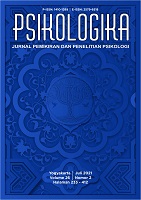Main Article Content
Abstract
Innovative work behavior is one of the keys to trust and success for organizations. In this era, how to form employees is a challenge and important for innovative organizations to see the factors that cause innovative behavior in their employees. This study involved three variables, namely openness to experience, ambidextrous organizational culture, and innovative work behavior. By using 3 measuring instruments, namely The Big Five Personality Inventory (BFI), Innovation Behavior Scale, and Ambidextreus Organizational Scale, as many as 127 respondents were obtained using the bold self-report method. Researchers examined the moderating role of ambidextrous organizational culture as analyzed by the PROCESS statistical technique developed by Hayes. The results showed a positive relationship between OTE and ambidextrous organizational culture was proven to be a significant predictor of employee innovative work behavior. F = 25.1475, p < .001, R2 = .384. From these results, it can be calculated that 38.4% variants of the two predictions have a significant effect on innovative work behavior. However, through the analysis it is also known that there is no significant interaction between the ambidextrous organizational culture variables, thus the the first hypothesis is accepted but not the second hypothesis. The result of this research can help companies to identify openness traits of the prospective employees.
Article Details
Authors who publish with this journal agree to the following terms:
- Authors retain copyright and grant the journal right of first publication with the work simultaneously licensed under a Creative Commons Attribution-ShareAlike 4.0 International License that allows others to share the work with an acknowledgment of the work's authorship and initial publication in this journal.
- Authors are able to enter into separate, additional contractual arrangements for the non-exclusive distribution of the journal's published version of the work (e.g., post it to an institutional repository or publish it in a book), with an acknowledgment of its initial publication in this journal.
- Authors are permitted and encouraged to post their work online (e.g., in institutional repositories or on their website) prior to and during the submission process, as it can lead to productive exchanges, as well as earlier and greater citation of published work (See The Effect of Open Access).




